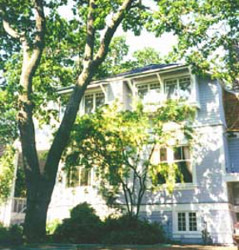Local Knowledge About Passive Cooling Design

Being inside a building without air conditioning on a warm day can be uncomfortable unless the design includes features that facilitate passive cooling. This house, which uses passive cooling techniques, can remain comfortably cool on hot summer days without adding to the electric bill. Passive cooling uses non-mechanical methods of reducing heat
gain by increasing air circulation and decreasing solar radiation absorbed by the building. The most effective method to cool your home is to keep the heat from building up in the first place. The primary source of heat buildup (i.e., heat gain) is sunlight absorbed by your house through the windows, roof and walls. Secondary sources are heat-generating appliances in the home and air leakage. Shading is a common sense cooling technique. Effectively shading a house can reduce indoor temperatures by as much as 20 degrees F. Another effective way to control solar heat gain in the summer is by using overhangs, porches, awnings and shades. Exterior shades are generally much more effective than interior shades because they do not allow sunlight to reach the windows.
 Being inside a building without air conditioning on a warm day can be uncomfortable unless the design includes features that facilitate passive cooling. This house, which uses passive cooling techniques, can remain comfortably cool on hot summer days without adding to the electric bill. Passive cooling uses non-mechanical methods of reducing heat
gain by increasing air circulation and decreasing solar radiation absorbed by the building. The most effective method to cool your home is to keep the heat from building up in the first place. The primary source of heat buildup (i.e., heat gain) is sunlight absorbed by your house through the windows, roof and walls. Secondary sources are heat-generating appliances in the home and air leakage. Shading is a common sense cooling technique. Effectively shading a house can reduce indoor temperatures by as much as 20 degrees F. Another effective way to control solar heat gain in the summer is by using overhangs, porches, awnings and shades. Exterior shades are generally much more effective than interior shades because they do not allow sunlight to reach the windows.
Being inside a building without air conditioning on a warm day can be uncomfortable unless the design includes features that facilitate passive cooling. This house, which uses passive cooling techniques, can remain comfortably cool on hot summer days without adding to the electric bill. Passive cooling uses non-mechanical methods of reducing heat
gain by increasing air circulation and decreasing solar radiation absorbed by the building. The most effective method to cool your home is to keep the heat from building up in the first place. The primary source of heat buildup (i.e., heat gain) is sunlight absorbed by your house through the windows, roof and walls. Secondary sources are heat-generating appliances in the home and air leakage. Shading is a common sense cooling technique. Effectively shading a house can reduce indoor temperatures by as much as 20 degrees F. Another effective way to control solar heat gain in the summer is by using overhangs, porches, awnings and shades. Exterior shades are generally much more effective than interior shades because they do not allow sunlight to reach the windows.